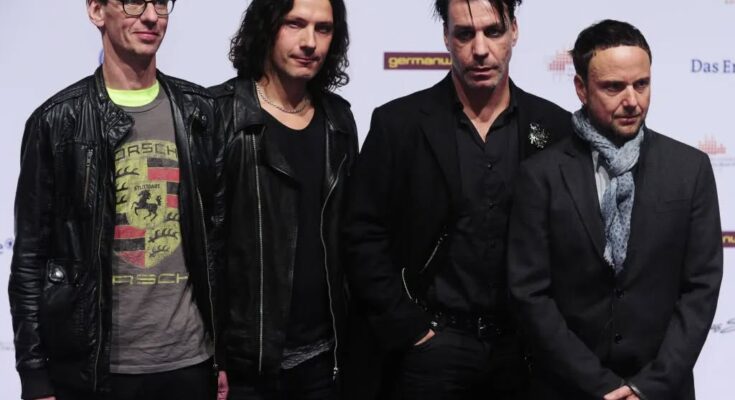“Deutschland” Controversy Rekindled: Demands to Ban Rammstein’s Music Video Over Accusations of “Historical Irresponsibility”
The controversy surrounding Rammstein’s “Deutschland” has resurfaced once again, sparking renewed debates and calls for censorship over what critics have labeled as a “historically irresponsible” music video. When the video was first released, it immediately became one of the most polarizing cultural moments in recent German music history, not only because of the band’s penchant for dramatic visuals and provocative artistry but also due to the weight of history it dared to engage with. Rammstein has never shied away from controversy, often using their art to poke at taboos, provoke discussion, and force audiences to confront uncomfortable truths, but “Deutschland” brought those instincts into perhaps their most sensitive territory yet: Germany’s turbulent past.
The video itself is a cinematic work that spans thousands of years of German history, told through powerful and often shocking imagery. Scenes leap from Roman conquests to medieval battles, from the Thirty Years’ War to the industrial age, from the rise and fall of the Third Reich to the divided Cold War era, all with the band members embodying different roles across time. The most controversial sequence, however, remains the one in which the band appears in concentration camp uniforms, with nooses around their necks, awaiting execution. For some, this was a provocative artistic statement highlighting the darkest chapters of German history; for others, it was an unacceptable exploitation of unimaginable suffering for the sake of entertainment.
As soon as the video premiered, cultural commentators, politicians, and survivors’ groups weighed in. Critics denounced the imagery as trivializing the Holocaust, arguing that such depictions, when placed in a commercial music video, risk stripping away the gravity of one of humanity’s greatest tragedies. On the other side, defenders of Rammstein emphasized the context of the piece, arguing that the video was not glorifying or mocking history but instead holding up a mirror to the very violence, contradictions, and burdens of German identity across centuries. The band itself insisted that the intention was to confront history head-on rather than shy away from it, making an artistic statement about the struggles of national identity, pride, and shame.
Years after its release, however, the “Deutschland” video still remains a lightning rod for debate. The recent resurgence of the scandal has been fueled by growing discussions around media responsibility, censorship, and the line between free expression and historical sensitivity. Some cultural critics argue that, in today’s environment where far-right movements have been gaining momentum in parts of Europe, such imagery could be co-opted or misinterpreted, giving unintended power to extremist narratives. They contend that artists have a duty to be mindful not only of what they create but also how their work may be weaponized in broader societal contexts.
On the flip side, voices defending artistic freedom warn that censoring works like “Deutschland” sets a dangerous precedent. Rammstein has always thrived on pushing boundaries, blending industrial metal with theatrical shock value, and their work often provokes because it is designed to. To strip away their ability to challenge audiences, critics argue, would neuter the very power of art as a form of societal reflection. For supporters of the band, “Deutschland” is not historically irresponsible but instead brutally honest, daring to depict a nation’s glory and shame with equal weight. They see the calls for censorship as an attempt to sanitize history rather than confront it.
What complicates the matter is the global reach of Rammstein. As one of the most internationally recognized German bands, their work has become synonymous with the image of German cultural exports. For some, that amplifies the responsibility they bear; for others, it highlights the universality of their art. Fans across the world saw “Deutschland” as more than a chronicle of German history but as a commentary on the cycles of human violence, nationalism, division, and survival that transcend borders. The recent flare-up in calls for censorship underscores how the video continues to tap into raw nerves, with Germany’s unique relationship to its past making it especially fraught.
Politicians have waded into the discussion once more, with some suggesting that platforms should restrict or label the video to prevent misinterpretation, while others insist that censorship only suppresses difficult but necessary dialogue. Survivor advocacy groups remain divided, too; some feel that the Holocaust should never be used in popular culture, regardless of intent, while others believe that confronting such imagery can keep the memory alive in younger generations who may otherwise disengage from history. The debate reveals a generational divide as well: younger fans tend to view the video through the lens of artistic expression and commentary, while older generations, more directly connected to the aftermath of World War II, often find the imagery intolerably painful.
The controversy also touches on broader questions about how nations deal with their pasts. Germany has long been seen as a country that confronts its historical crimes with unusual honesty, through education, memorials, and public discourse. Yet even in such a society, or perhaps especially in such a society, cultural expressions that revisit those horrors risk reopening wounds. “Deutschland” is controversial precisely because it refuses to let history sit comfortably in textbooks or museums—it thrusts it into popular culture, forcing engagement in a space not always designed for solemnity. That collision between entertainment and historical memory is at the heart of why the debate continues to burn so intensely.
Supporters of Rammstein argue that banning the video would do little more than drive it underground while fueling the myth of censorship itself, making it more alluring to those inclined to misinterpret it. They suggest that the better response is open dialogue, contextualization, and discussion, allowing the video to serve as a teaching tool rather than a forbidden artifact. In their eyes, “Deutschland” is one of the rare pieces of mainstream art willing to wrestle with history’s ugliest chapters without disguising them, and attempting to erase it would be counterproductive.
What remains clear is that Rammstein thrives on exactly this kind of tension. Throughout their career, they have courted outrage while insisting on the legitimacy of their artistry, walking the fine line between spectacle and statement. With “Deutschland,” they produced a piece that is as unsettling as it is unforgettable, ensuring its place not just in music history but also in cultural and political debates about memory, responsibility, and freedom of expression. The renewed calls for censorship only cement the video’s controversial legacy, proving that years later, it still has the power to provoke, unsettle, and demand conversation.
The rekindled scandal surrounding “Deutschland” demonstrates how art and history remain deeply intertwined, particularly in societies that continue to grapple with unresolved traumas. Whether one views the video as a necessary confrontation or an unacceptable trivialization, its impact cannot be denied. The controversy is unlikely to disappear anytime soon, for as long as Rammstein exists, the band will continue to press against the boundaries of what is considered permissible in art. “Deutschland” will remain a lightning rod because it embodies the very tension between memory and identity, freedom and responsibility, that continues to define debates about culture in Germany and beyond.



